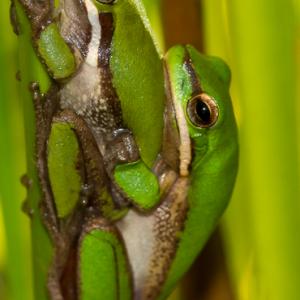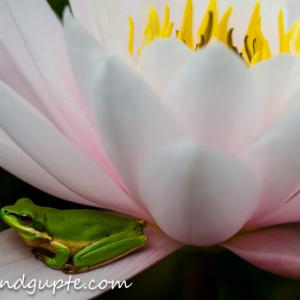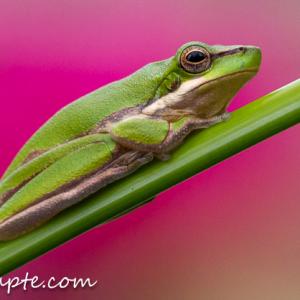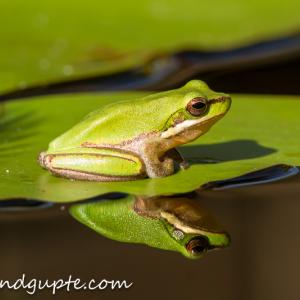Eastern Sedge Frog (Litoria fallax)
Eastern Sedge Frog (Litoria fallax)
The word “ugly” is often used in conjunction with a frog. The expression “ugly frog” or “ugly as a frog” is found in literature. I find the little “Eastern Sedge Frog” far from ugly, in fact beautiful and fascinating, so much, that I spent the last summer chasing it where ever I could find it. This is a tiny frog common in Brisbane. It is usually in and on vegetation around water bodies even little ponds. It is green in colour with some variations and even brownish. It is usually more common during the hot months. This year I followed them in different ponds and water bodies and gardens. They make an ideal macro subject with a contrasting dark stripe running from their nostril to the eye. Back of the thigh is orange in some of them. They feed on mosquitoes and other flying insects. I got shots of the full-grown ones and the immature ones and the tadpoles with their long tails. Shot them clinging to the reeds, perching on flower petals and buds and floating vegetation. Because they are so small [ 25-30 mm for an adult] they can easily sit on a petal or a floating leaf comfortably.
I tried photographing them with a 100mm 2.8 macro lens, but they used to be just out of reach, in the middle of the pond, for a decent shot. Bending over or trying to reach them was risky [ for the camera and the lens]. I did not fancy falling in the murky water with a lens and the camera round my neck.
My next option was my close focusing 300mm F4 lens. It did an admirable job of capturing images of the frogs and I could do it from a distance safely and without disturbing them. On one occasion I even used the Canon EF 200-400 f/4 IS USM Lens when the frog sunning itself on a leaf was out of the range of the 300 F4 lens.
You always have a surprise in store for you as to where you are going to find them. One morning you will find them on the leaves and on another day in another pond they will be on the flowers or their stems. This summer was quite wet in Brisbane and after a heavy shower if you head for the ponds you will find these frogs very active.
I had fun chasing them over summer and now as we are heading to winter there are fewer to be seen and photographed.
I used my monopod when I found the frogs above ground level and other times just handheld when I wanted to get close to the ground. I have found the Canon 300 F4 lens, though an older design, to be very sharp and the Image stabilizer system on it works well. It is also my walkabout lens for birds and animals when I don’t want to be carrying the big Canon 200-400 F4 IS lens. Moreover it comes in handy not only for the bigger species of birds and animals but also for the likes of dragon flies, damsel flies and butterflies and other larger insects even frogs
I have blown up images shot with the Canon EF 300 f4 IS USM to A0 size without a problem.
With the frog season now coming to an end I will be looking for other subjects to photograph.





